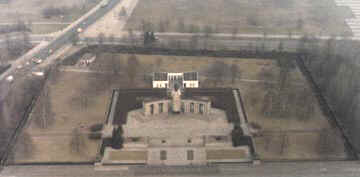
Soviet Denkmal (War Memorial) in the Tiergarten by the Brandenberg Gate. It is a wide triumphal gate constructed with marble taken from the ruins of the Chancellory. It is topped off with a bronze figure of a Soviet Soldier. The Soviets thought the area was within the "Mitte" section of Berlin, which was under their control. It is actually in the (then) British sector. The Soviet soldiers have their ceremonial guards 24 hours a day and 7 days a week. However, the whole area was protected by the British. |
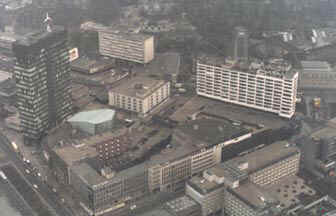
The Europa Center, located east of the remains of the Kaiser Wilhelm Gedachtniskirche (Memorial Church), is a huge business center. It was erected in 1965, and is grouped around two courts. The tall building is 22 stories high. |
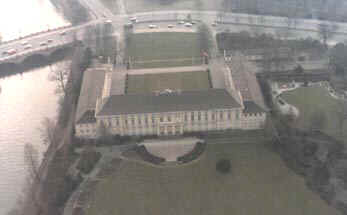
Schloss Bellevue, shown next to the Spreeweg, is the official Berlin residence of the President of the Federal Republic. In the foreground is the "Englisher Garten" that includes plants from the British Royal Family and several British cities. It was reconstructed in 1952. The Schloss was first built as a summer palace for Prince August Ferdinand (Friederich the Great's youngest brother) in 1785. It was badly damaged during World War 2. But, the exterior was faithfully restored by 1959. |

Grosser Stern (the Round-A-Bout) and the Siegessaule (Column of Victory). The Grosser Stern is nearly 200 yards wide and has avenues radiating in 5 directions. It is a remnant of the baroque period of the Tiergarten. The large number of auto lanes were added in 1938. The Siegessaule is 220 feet high and has 285 steps to a platforem 157 feet high. It was erected in 1865-73 originally at the Konigsplatz (called now the Platz der Republic), to commerate victories over Denmark in 1864, Austria in 1866 and France in 1870-71. It was moved to here in 1938-1939. The Goddess of Victory on the top is 27 1/4 feet tall and weighs 40 tons. |
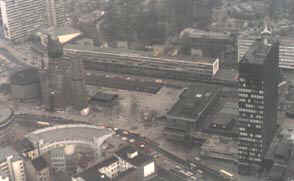
On the left is the Kaiser Wilhelm Gedachtniskirche (Emperor William Memorial Church). The old church was built in 1891-95, and was badly damaged during World War 2. The ruins of the west tower at 207 feet high is all that remains. (I have included several photos of the inside, below.) In 1961, a new church, the flat roof octagon and the hexagonal tower at 174 feet high, were built. They are comically called the "powder-box and lipstick." A carillon installed in the old tower, on the hour, plays a tune composed by Prince Louis Ferdinand. |
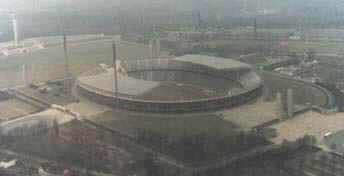
The Olympia Stadium was built for the 11th Olympic Games of 1936. It replaced an earlier Deutsches Stadion that was built in 1913 for the 1916 Olympics, which had been cancelled because of the World War 1. It is a large oval shape in concrete with its facing of Shelly limestone. It is 328 by 252 yards and can handle about 100,000 spectators. |
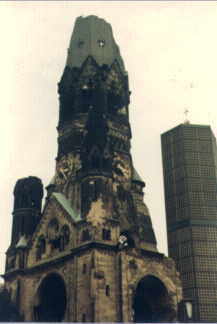
Here is the Kaiser Wilhelm from the surface. |
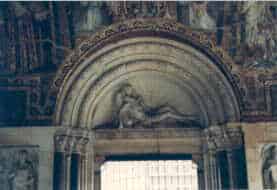
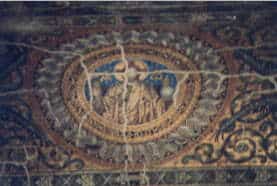
Two photos taken of the inside of the remains of the left tower. |

Schloss Charlottenburg (the long building), the Antikenabteilung (the Antique Department with the blue dome on the left), the Aegyptisches Museum (The Egyptian Museum with the blue dome on the right) are all located on the Schloss Strasse. The Schloss is the best remaining example of Prussian architecture in Berlin. It started in 1695 as a country house for Sophie Charlotte, wife of Elector Friedrich III. In 1698 were added two wings flanking the courtyard. In 1702, von Goethe converted the main building and wings into a three sided building around a "Court of Honor," similar to that at Versaille. In 1712, it was further enlarged and included the 158 foot domed tower. The east and west wings were also built during the 1700's, making the total length 552 yards.The palace was badly damaged during World War 2. The exterior was completely restored by 1972. By the 1980's the whole complex was a museum with the Schloss faithfully restored to look as it did in the past. The Antique Museum had pre Hellenic and Greek objects of art. The Egyptian Museum shows a history of Egyptian art and culture from 5000 BC to the Greco-Roman period, 300 AD. One of its most import objects is perhaps the limestone bust of Queen Nefertiti (Pictured on the right,) |
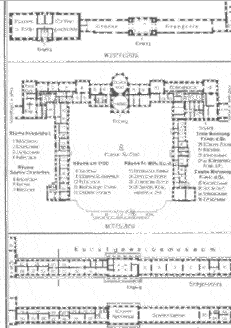
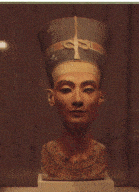 |

International Conference Center is the building with external ribs. The main room can handle 5000 persons, the banquet hall 3000. There are 80 conference rooms. The Funkturm (TV tower) is 453 feet high (plus its antennae) and is made of steel lattice structure. The tower was built in 1926. It has a restaurant at 180 feet and a viewing platform at 410 feet. The remaining buildings are part of the huge Ausstelungs und Messegelande (Exhibition and Fairgrounds). There are well over 100,000 square yards of exhibition space under roof. Construction started during World War 1, with additions in 1926. More building were added after 1936, with the last five built in 1975. |
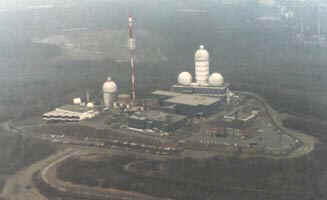
One of the three "Teuffelberg" (Devil's Mountains). This is the tallest of the three at 377 feet.. This is a man-made mountain dating from the post World War 2 period and was built from the rubble remains from the ruins of Berlin. It had (at the time pictured) been called the "Radar Tower," although none of the domes had radiating antennae. This is the place I worked for three years. The facility (then) was the U.S. Army's Field Station Berlin. During my last visit in 1999, the facility was completely deserted except for a lone security guard. He told me that a civilian firm had bought it and was in the process of converting it to a hotel and restaurant complex. |

Spandau Prison was built as a 19th Century penitentiary. The buildings are of a pseudo-medieval, red-brick fortress. It was built in 1876 to hold 500 prisoners as a military detention center. After World War 2 it held the seven Nazi leaders sentenced from Nuremberg. But, since 1966, its only prisoner was Rudolph Hess (1894 - 1987) until his death on 17 August 1987. Just after his death the British Forces decided to completely destroy it to prevent it from becoming a shrine. Photographs were strictly forbidden, so this is a rare photo from the air. Each of the four powers then in Berlin, British, American, French, and Soviets rotated the service on guard duty and support at the prison for a month at a time .
|
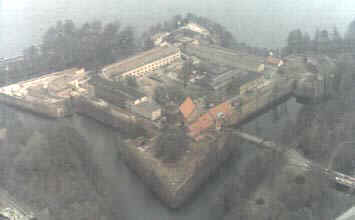
The Zitadelle Spandau, located on the Havel River, is an Italian style of fortification of the 16th Century. It was built by Joachim II, starting in 1560 to protect his capital. It is in the form of a square with sides about 220 yards each, with water completely surrounding it. The four bastions have names, Koenig in the foreground, Koenigin on the right, Kronprinz on the left and Brandenburg in the rear. Access today is still by the narrow drawbridge shown to the right of the Koenig bastion. The Julius Tower just behind the Koenig bastion rises 100 feet and is the oldest existing building in the Citadel. It dates from the beginning of the 14th Century as a watch tower and place of last refuge. |

Another corner view of the Berlin Wall. Here, it borders East Germany. In the upper right corner is part of a Collective Farm in East Germany.
|

Andrews Kasern, the headquarters of the (then) U.S Army's Intelligence and Security Command (INSCOM) in Berlin. Off to the right is the large indoor swimnming pool built in 1938, after the 1936 Olympic games.
|

















